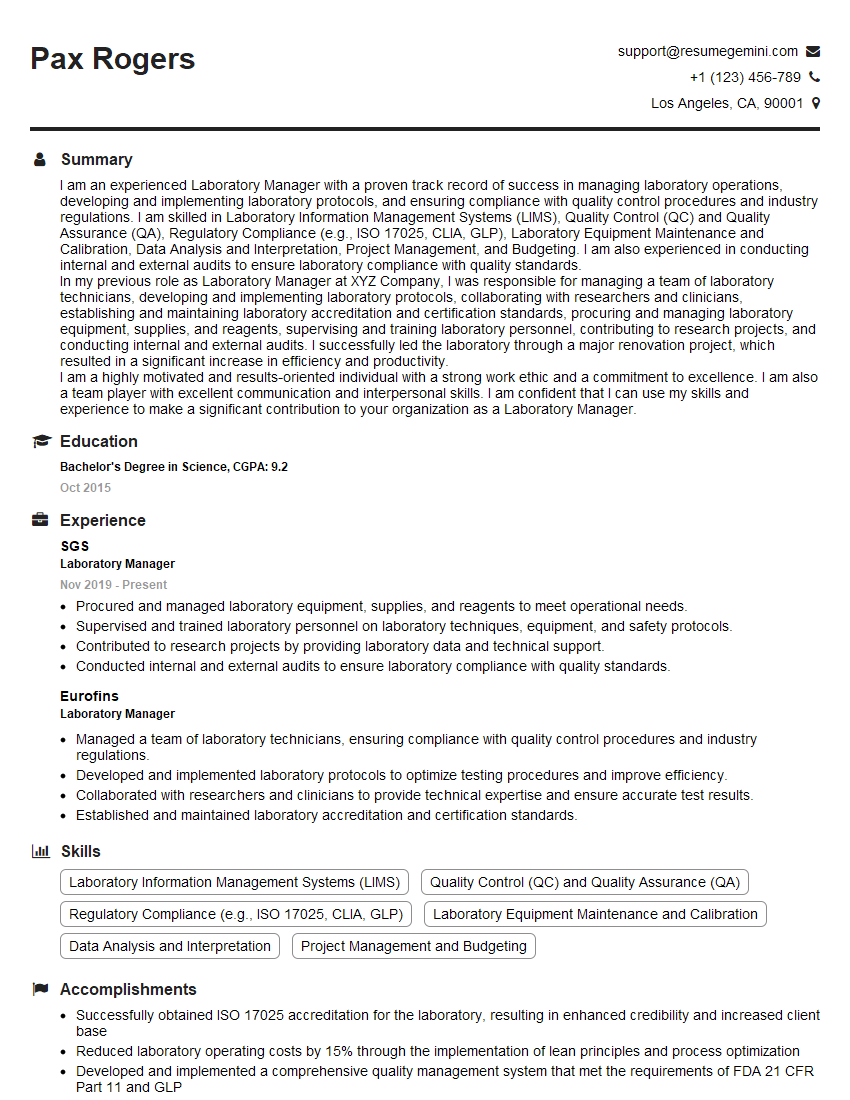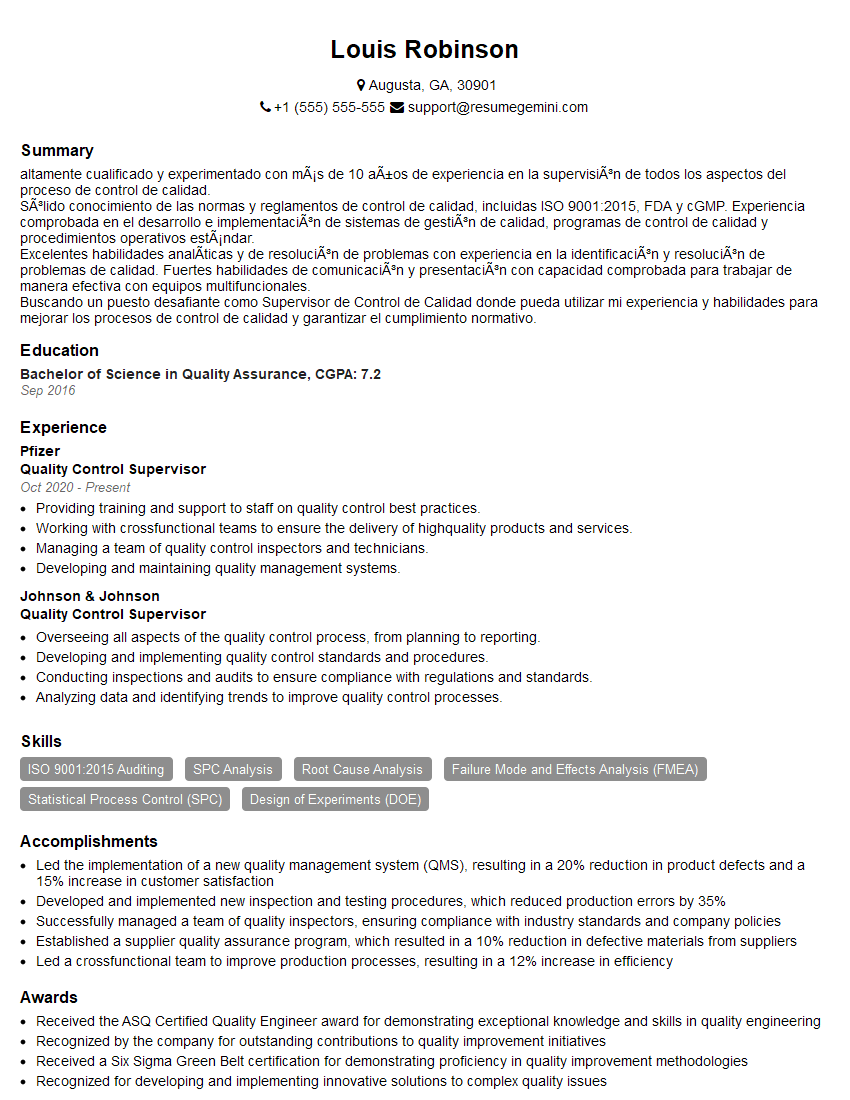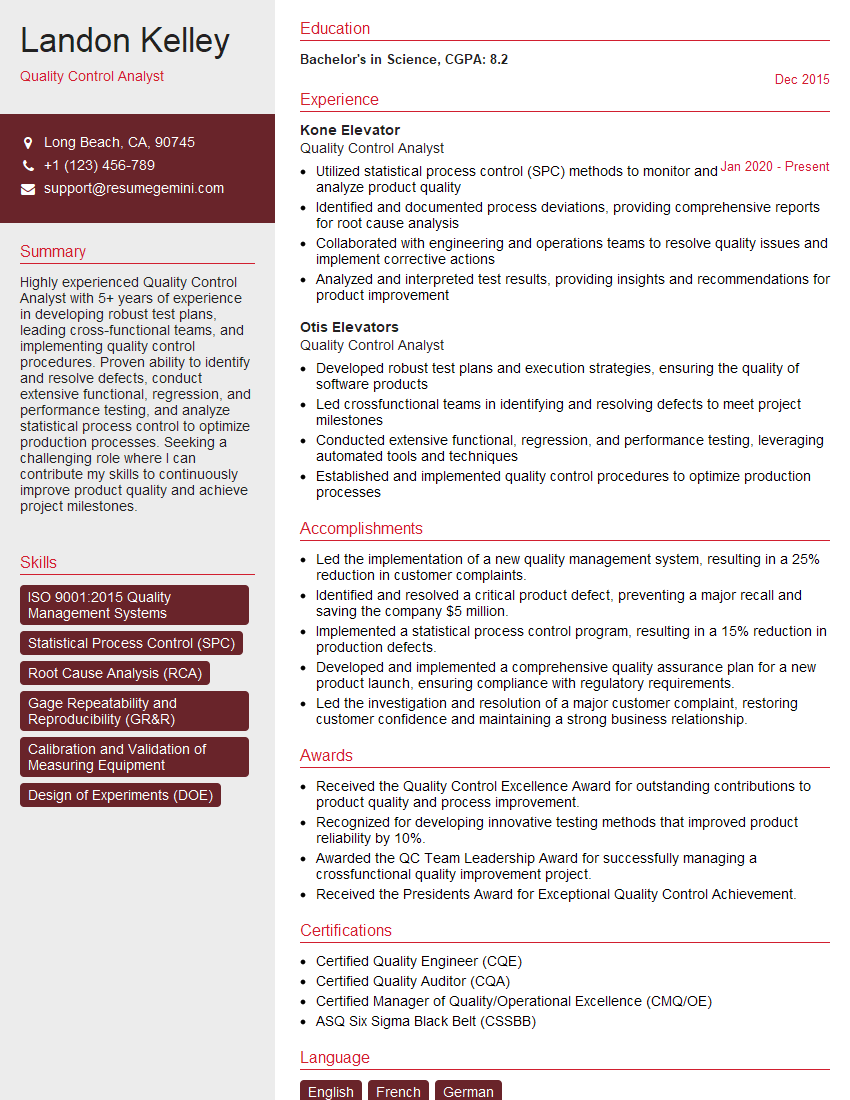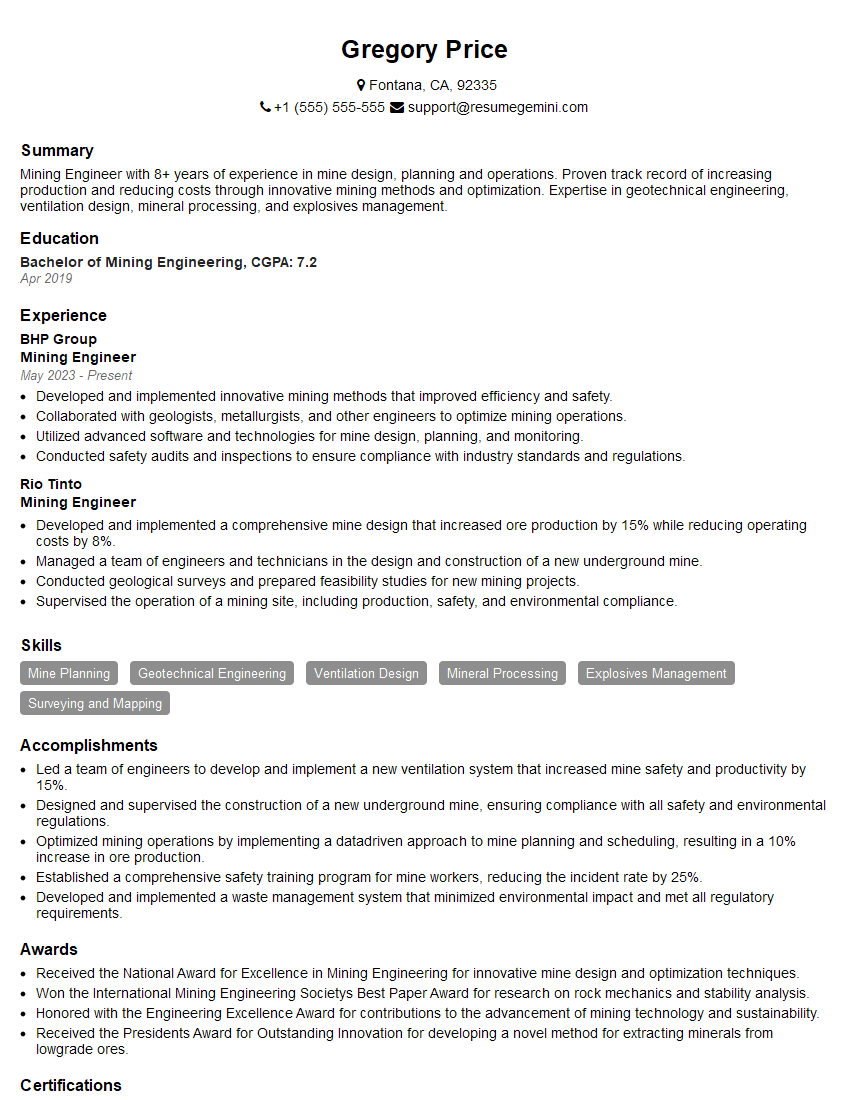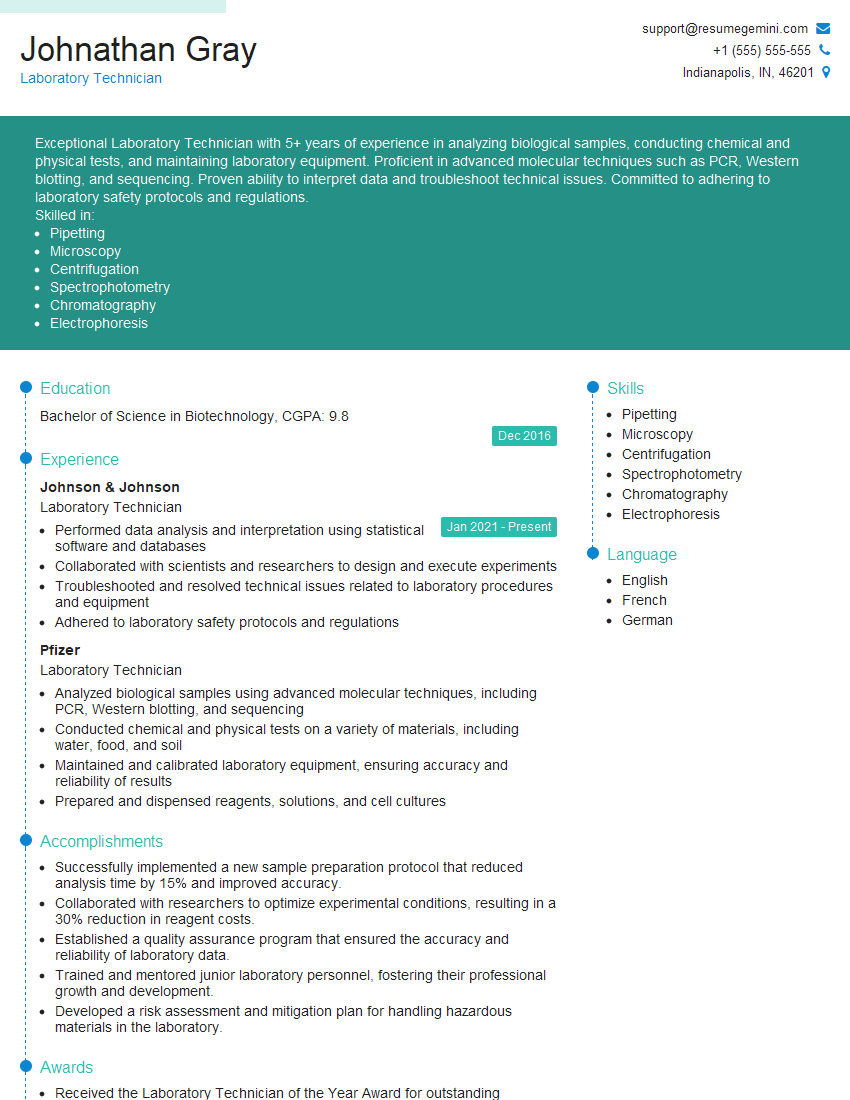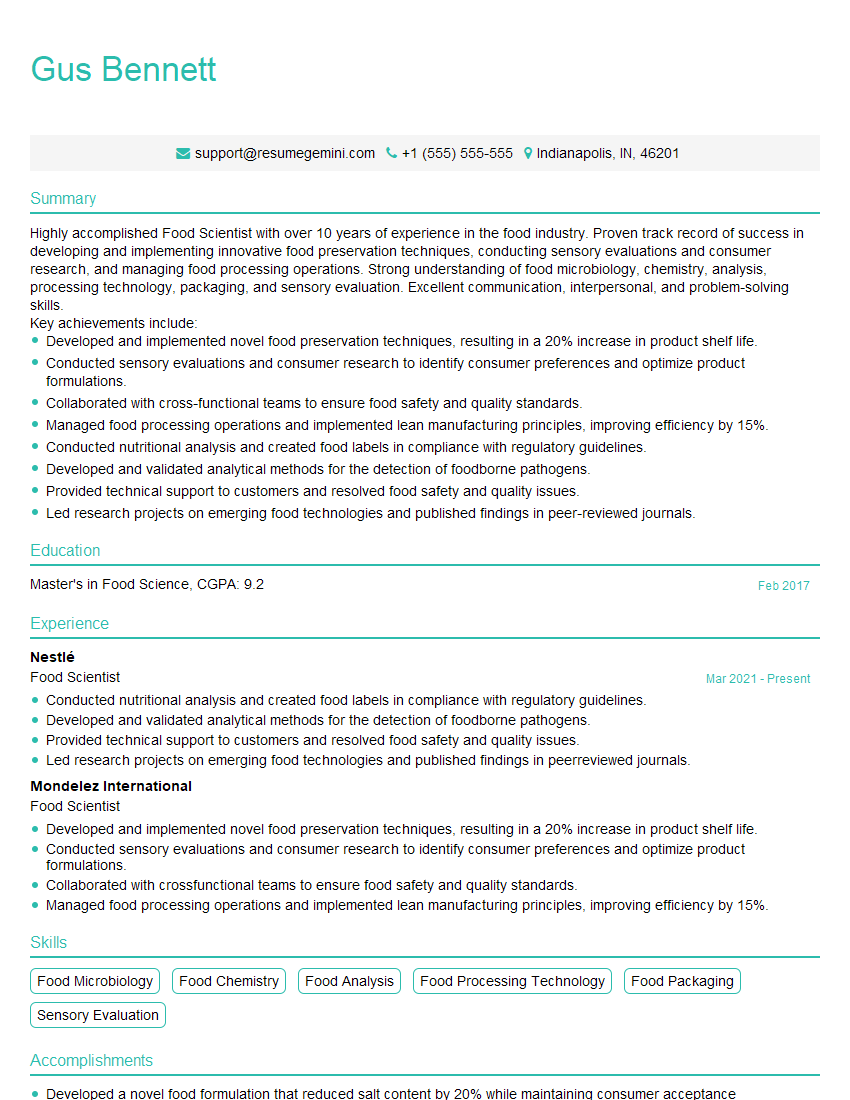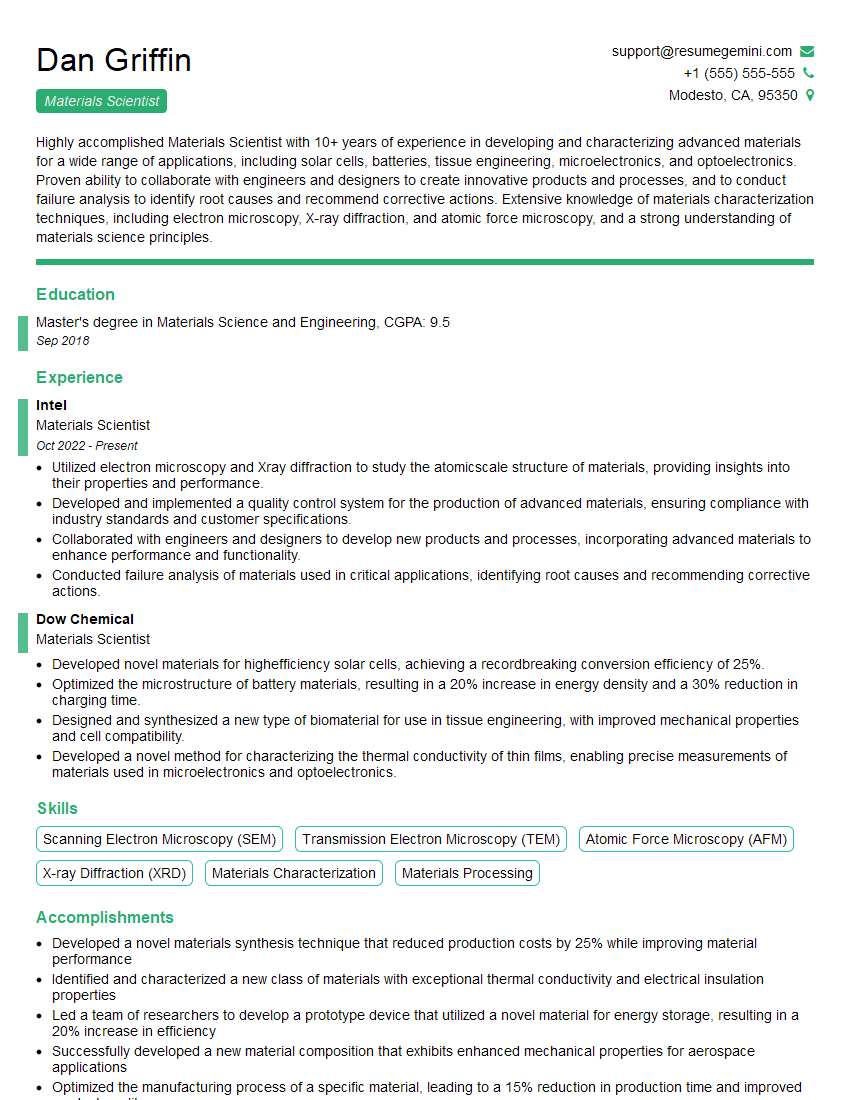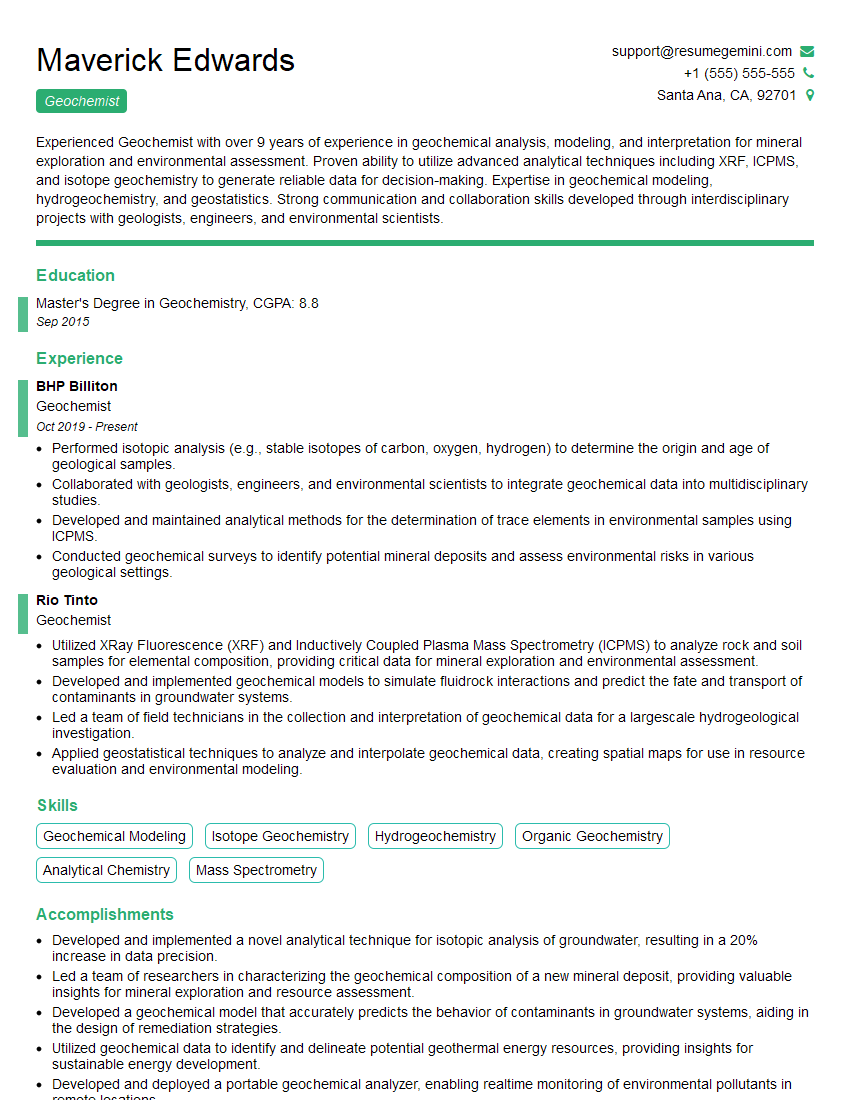Unlock your full potential by mastering the most common Ash Content Determination interview questions. This blog offers a deep dive into the critical topics, ensuring you’re not only prepared to answer but to excel. With these insights, you’ll approach your interview with clarity and confidence.
Questions Asked in Ash Content Determination Interview
Q 1. Explain the principle behind ash content determination.
Ash content determination is a crucial analytical technique used to quantify the inorganic mineral residue remaining after the organic matter in a sample has been completely burned off. Imagine you’re burning a piece of wood – what’s left behind is mostly ash, representing the inorganic components. Similarly, in ash content determination, we’re essentially determining the percentage of inorganic material present in a sample.
The principle relies on the complete oxidation of organic components at high temperatures, leaving behind only the non-combustible inorganic residue. This residue, primarily composed of minerals like oxides of calcium, magnesium, potassium, and sodium, provides valuable information about the sample’s composition and quality.
Q 2. Describe different methods for ash content determination (e.g., muffle furnace, microwave digestion).
Several methods exist for ash content determination, each with its strengths and limitations:
- Muffle Furnace Method: This is the most common and widely accepted method. The sample is placed in a crucible and heated in a muffle furnace at a controlled temperature (typically 550-600°C) until a constant weight is achieved. This signifies that all organic matter has been burned off. The remaining weight represents the ash content.
- Microwave Digestion: This method utilizes microwave energy to accelerate the ashing process. It’s faster than the muffle furnace method but requires specialized equipment and may not be suitable for all sample types. The sample is typically treated with strong acids prior to microwave digestion to ensure complete decomposition of organic matter.
- Other Methods: Other less common methods include low-temperature plasma ashing, which is better suited for volatile components, and dry ashing, where a sample is heated gradually in an open crucible, primarily useful for certain types of food samples.
The choice of method depends on factors like the sample type, available equipment, and desired turnaround time. For instance, a food sample might be analyzed using the muffle furnace method, while a sample containing volatile components might require low-temperature plasma ashing to prevent loss of analytes.
Q 3. What are the sources of error in ash content determination, and how can they be minimized?
Several sources of error can affect ash content determination, leading to inaccurate results. These include:
- Incomplete Combustion: Insufficient heating time or temperature can leave residual organic matter, leading to an underestimation of ash content. Proper temperature and time control are crucial.
- Sample Loss: Volatile components may be lost during heating, especially at higher temperatures. This can lead to a lower ash content than what’s actually present. Using covered crucibles can minimize this.
- Contamination: Crucible contamination from previous samples or the environment can affect the results. Thorough cleaning of crucibles before and after use is essential.
- Absorption of Moisture: The ash residue can absorb moisture from the atmosphere after ashing, increasing the final weight. Crucibles should be cooled in a desiccator before weighing.
Minimizing these errors requires careful attention to detail, including precise weighing, appropriate heating conditions, the use of clean crucibles, and proper handling procedures. Using duplicate samples and employing quality control measures like standard reference materials can also enhance accuracy and reliability.
Q 4. What is the significance of ash content in different industries (e.g., food, pharmaceuticals, coal)?
Ash content is a critical parameter in various industries, providing insights into product quality and safety:
- Food Industry: Ash content indicates the mineral content of food, crucial for nutritional labeling and assessing quality. High ash content might indicate adulteration in some cases.
- Pharmaceutical Industry: Ash content determination is crucial for evaluating the purity of raw materials and finished products. It helps ensure that the product meets the quality standards set for pharmaceutical substances.
- Coal Industry: Ash content in coal is a major factor influencing its combustion efficiency and the production of pollutants. High ash content can reduce energy output and increase environmental concerns.
- Agricultural Industry: Ash content in fertilizers and soils is an important indicator of the nutrient level and overall soil quality.
In each of these instances, understanding the ash content allows for better quality control, efficient production processes, and ensuring product safety and regulatory compliance.
Q 5. How do you prepare a sample for ash content determination?
Sample preparation is a crucial step that significantly impacts the accuracy of ash content determination. The procedure varies depending on the sample type but generally involves:
- Weighing: Accurately weigh a representative sample (typically 1-5 grams, depending on the expected ash content and sample homogeneity) into a clean, pre-weighed crucible.
- Drying (Optional): If the sample contains significant moisture, it should be dried in an oven at a low temperature (e.g., 105°C) until a constant weight is achieved. This prevents spattering during ashing.
- Charring (Optional): Some samples might benefit from initial charring in a low-temperature oven, before ashing at a higher temperature. This helps minimize spattering and potential loss of sample during the ashing stage.
- Ashing: The sample is transferred to a muffle furnace or microwave digester for ashing. Specific temperature and time are crucial for complete ashing without contamination.
The method of preparing the sample is directly related to its type and nature. For instance, preparing a liquid sample necessitates evaporation before ashing to prevent spattering. It’s paramount to choose a sample preparation method that minimizes sample loss and contamination.
Q 6. What are the appropriate temperatures and heating times for ashing different materials?
The appropriate temperature and heating time for ashing vary significantly depending on the sample type and desired outcome. There isn’t a single universal setting. Generally:
- Temperature: A common temperature range for ashing is 500-600°C. However, some samples might require lower temperatures (e.g., 450°C for easily volatile samples) or higher temperatures (e.g., 700-800°C for refractory materials).
- Time: The heating time depends on the sample’s nature and the temperature used. It usually ranges from a few hours to overnight. Complete ashing is confirmed when the weight of the residue becomes constant after successive ashing intervals.
Always refer to relevant standards or literature specific to the sample type to determine the optimal temperature and time for accurate ash content determination. For example, the ashing temperature for food samples might differ significantly from that of coal.
Q 7. How do you calculate the ash content percentage?
The ash content percentage is calculated using the following formula:
Ash Content (%) = [(Weight of ash (g) / Weight of sample (g)) x 100]
Where:
- Weight of ash (g) is the weight of the residue remaining in the crucible after ashing.
- Weight of sample (g) is the initial weight of the sample before ashing.
For example, if a 2.000g sample leaves a 0.100g ash residue, the ash content is calculated as: [(0.100g / 2.000g) x 100] = 5%
It’s crucial to accurately record all weights and to ensure the sample has been completely ashed to obtain reliable results. Any error in weighing will directly affect the final ash content percentage. Accurate weighing instruments and proper weighing techniques are essential to the calculation.
Q 8. What are the safety precautions you need to consider during ash content determination?
Safety is paramount during ash content determination. The process involves high temperatures and potentially hazardous materials. Crucial precautions include wearing appropriate personal protective equipment (PPE), such as heat-resistant gloves, safety glasses, and a lab coat. The crucible, especially after ashing, can be extremely hot, so using tongs or crucible holders is essential. The furnace should be operated in a well-ventilated area to avoid inhaling fumes. Proper handling of the sample before ashing is equally important; avoid direct contact with potentially harmful substances. Finally, always follow your lab’s specific safety protocols and procedures.
For example, imagine you’re working with a sample suspected to contain heavy metals. You would need to take extra precautions to prevent inhalation or skin contact, possibly using a fume hood and specialized waste disposal methods.
Q 9. Explain the difference between volatile matter and ash content.
Volatile matter and ash content represent different components lost from a sample during heating. Volatile matter refers to the material that evaporates or decomposes at relatively low temperatures, typically below 600°C (1112°F). This includes things like moisture, organic matter, and some volatile inorganic compounds. Think of it as the ‘stuff that burns off’.
Ash content, on the other hand, represents the inorganic residue remaining after complete combustion or decomposition at high temperatures, typically around 550-600°C (1022-1112°F), or even higher depending on the sample matrix. This residue is primarily composed of metal oxides and other inorganic compounds. It’s the ‘stuff that’s left behind’.
Imagine burning a piece of wood. The volatile matter would be the smoke and gases produced during burning, while the ash is the remaining gray residue.
Q 10. What is the role of a crucible in ash determination?
The crucible is a fundamental tool in ash determination, acting as a container for the sample during the ashing process. It must withstand high temperatures without reacting with the sample or breaking. Its role is to safely hold the sample while it is heated to high temperatures, allowing for the complete combustion of the volatile matter and determination of the remaining ash. The crucible’s material should be chemically inert to the sample; a common choice is porcelain or platinum, depending on the sample composition and required accuracy. The crucible’s weight must be accurately determined before and after ashing to calculate the mass of the ash.
For instance, a platinum crucible is preferred for samples that might react with porcelain, potentially compromising the results. The inert nature of the platinum ensures no interference with the ashing process.
Q 11. How do you handle and clean crucibles before and after analysis?
Proper handling and cleaning of crucibles are crucial for accurate ash determination. Before analysis, crucibles must be thoroughly cleaned to remove any contamination that could interfere with the results. This typically involves washing with a suitable detergent and deionized water, followed by rinsing with distilled water and drying in an oven at a temperature that ensures complete dryness without causing damage to the crucible. After ashing, the crucible should be carefully cooled before handling (this step is crucial for preventing burns!) and cleaned again as mentioned before. Any residual ash should be removed gently to avoid scratching the crucible’s surface.
Imagine forgetting to clean the crucible thoroughly before weighing the sample. Any residual from the previous analysis would add to the weight and lead to an inaccurate ash content determination.
Q 12. Explain the importance of sample size in ash determination.
The sample size plays a significant role in ash determination, influencing both the accuracy and precision of the results. A sufficiently large sample size helps minimize the impact of random errors and improves the representativeness of the sample. However, excessively large samples can lead to incomplete ashing, while a sample that is too small may result in significant errors due to the difficulty in accurately weighing a small amount of ash. The appropriate sample size depends on the expected ash content and the sensitivity of the weighing equipment. The standard operating procedures (SOPs) of your lab will dictate the recommended sample size for different matrices and techniques.
For instance, if you are analyzing a sample with very low ash content, you might need to use a larger sample size to ensure that the resulting ash is easily measurable and gives you an accurate representation of the overall composition. If your sample is heterogeneous, you must ensure sufficient sample size to achieve proper representativeness.
Q 13. How do you ensure the accuracy and precision of your ash content measurements?
Ensuring accuracy and precision in ash content measurement requires meticulous attention to detail throughout the entire process. This begins with accurate weighing of the empty crucible and the sample. Using calibrated analytical balances is essential. Consistent heating conditions are also critical, achieved by maintaining a stable temperature within the furnace. Complete ashing is crucial; this requires sufficient heating time, and often visual inspection to ensure the absence of carbon. Multiple analyses on replicate samples, with careful recording of the weights and temperatures, are essential to assess the precision of the results. Comparing the results to certified reference materials provides an assessment of accuracy.
Think of it like baking a cake. You need precise measurements of ingredients and consistent baking time and temperature to achieve consistent and reliable results.
Q 14. What are the limitations of the different ashing methods?
Different ashing methods, such as muffle furnace ashing, microwave ashing, and low-temperature plasma ashing, each have their limitations. Muffle furnace ashing, though widely used, can be time-consuming and may lead to losses of volatile elements at high temperatures. Microwave ashing is faster, but can cause sample splashing and uneven heating. Low-temperature plasma ashing is gentle, reducing losses of volatile elements, but it requires specialized equipment and can be expensive. The choice of method depends on the sample’s characteristics, the desired speed, and the acceptable level of accuracy. For example, samples containing volatile elements are better suited to low-temperature plasma ashing to minimize losses. Samples requiring faster processing might utilize microwave ashing despite the risk of uneven heating and potential for sample loss.
The choice of method is a balance between speed, accuracy, cost, and the characteristics of the sample itself.
Q 15. How do you interpret the results of ash content determination?
Interpreting ash content results involves understanding what the percentage represents and its implications for the sample’s quality and composition. The ash content, expressed as a percentage of the original sample weight, indicates the inorganic mineral matter remaining after the organic components have been completely burned off at high temperatures. A high ash content might suggest the presence of contaminants or impurities, affecting the product’s quality. Conversely, a low ash content can indicate a purer sample. For example, in the food industry, high ash content in flour could suggest soil contamination, affecting its baking properties. In coal analysis, ash content is crucial for determining its calorific value and suitability for combustion. We analyze the results within the context of established industry standards and specifications for the specific material being tested.
Career Expert Tips:
- Ace those interviews! Prepare effectively by reviewing the Top 50 Most Common Interview Questions on ResumeGemini.
- Navigate your job search with confidence! Explore a wide range of Career Tips on ResumeGemini. Learn about common challenges and recommendations to overcome them.
- Craft the perfect resume! Master the Art of Resume Writing with ResumeGemini’s guide. Showcase your unique qualifications and achievements effectively.
- Don’t miss out on holiday savings! Build your dream resume with ResumeGemini’s ATS optimized templates.
Q 16. What are the quality control checks you perform during ash content determination?
Quality control in ash content determination is paramount. We employ several checks. First, we meticulously weigh the crucible before and after ashing to ensure accurate mass differences, using calibrated analytical balances and checking their accuracy regularly. We use multiple crucibles for each sample to account for any crucible variation and to ensure reproducibility. A blank determination (ashing an empty crucible) is always performed to correct for any potential weight gain from the furnace atmosphere. Furthermore, we strictly adhere to the standardized temperature and ashing time specified in the relevant method (e.g., AOAC methods). We carefully document all steps, including observations such as the color and nature of the ash residue. Finally, we maintain a detailed log of all equipment calibration and maintenance, ensuring traceability and accuracy.
Q 17. How do you handle outliers or inconsistencies in your results?
Outliers and inconsistencies require careful investigation. First, we visually inspect the data for any obvious errors. We then examine the experimental procedure for any potential mistakes—for example, improper sample handling or weighing errors. If the discrepancy is significant, we repeat the analysis with a fresh sample, using a different crucible and different batches of reagents where applicable. Statistical analysis, such as calculating the standard deviation and performing Grubbs’ test for outlier detection, might be employed. If a consistent bias is observed, we might need to recalibrate the equipment or re-evaluate the ashing method. It’s crucial to document all steps taken to handle inconsistencies and their resolutions. The final reported result should accurately reflect the data after thorough investigation and appropriate correction.
Q 18. What is the role of standards and calibration in ash content determination?
Standards and calibration are the cornerstones of accurate ash content determination. We regularly use certified reference materials (CRMs) with known ash content to verify the accuracy of our method and equipment. These CRMs are analyzed alongside our samples and provide a benchmark against which our results can be compared. The furnace’s temperature is calibrated using certified thermometers or thermocouples, ensuring that the specified ashing temperature is consistently achieved. Our analytical balances are calibrated regularly to ensure accurate mass measurements. Proper calibration and use of certified reference materials minimizes systematic errors and guarantees that our results are reliable and traceable to internationally recognized standards.
Q 19. How would you troubleshoot problems encountered during ash determination?
Troubleshooting ash determination involves a systematic approach. If the ash residue is incompletely burned (e.g., presence of carbon), we increase the ashing temperature or extend the ashing time according to the method’s guidelines. If the crucible cracks during ashing, this points to a temperature ramp-up problem, requiring either a gentler heating profile or a more robust crucible material. Inconsistent results might indicate poor sample homogeneity, highlighting the need for better sample preparation. Issues with balance readings suggest the need for recalibration or cleaning. Documentation of every step is crucial to isolate and resolve issues. In any event, we always ensure our troubleshooting aligns with standard operating procedures and safety guidelines.
Q 20. Describe your experience with different types of furnaces used for ashing.
My experience encompasses various furnaces used for ashing, including muffle furnaces, which are commonly used for their even heating and temperature control, and microwave ashing systems which offer faster ashing times. Muffle furnaces are preferred for their robustness and simple operation, particularly suitable for routine analysis. Microwave ashing offers significant time savings, which is beneficial for high-throughput laboratories. However, it requires careful selection of sample size and the microwave power settings to avoid sample loss or incomplete ashing. The choice of furnace depends heavily on factors such as sample type, throughput requirements, and budget constraints. I am proficient in operating and maintaining both muffle and microwave ashing systems and can select the most appropriate technique for each application.
Q 21. What software or instruments have you used for ash content analysis?
I’ve extensively used various software and instruments for ash content analysis. This includes analytical balances from different manufacturers (e.g., Mettler Toledo, Sartorius) for precise mass measurements; muffle furnaces with programmable temperature controllers for precise temperature regulation; and data acquisition systems to record temperature and time. In some instances we use Laboratory Information Management Systems (LIMS) software for sample tracking, data management, and result reporting. My expertise lies not only in using the equipment but also in interpreting the data, ensuring the results are accurate and reliable within the context of the analysis and the standards required. Proficiency in using different software and instruments ensures efficient and high-quality ash content determinations.
Q 22. How do you ensure the traceability of your measurements?
Traceability in ash content determination is paramount for ensuring the reliability and validity of our results. It’s all about creating a clear, unbroken chain of custody for each sample, from its arrival in the lab to the final reported ash content. We achieve this through a meticulous system of documentation and record-keeping.
- Sample Identification: Each sample receives a unique identification number that is recorded in our laboratory information management system (LIMS) and on all associated documentation, including sample containers and analysis worksheets.
- Chain of Custody Forms: These forms track the sample’s movement through the laboratory, noting who handled it, when, and for what purpose. Any changes in sample condition are also documented.
- Instrument Calibration and Maintenance Logs: We maintain detailed logs for all our equipment, including furnaces, balances, and desiccators, documenting calibration dates, results, and any maintenance performed. This ensures the accuracy and precision of our measurements are consistently verifiable.
- Standard Operating Procedures (SOPs): We adhere strictly to written SOPs for every step of the ashing process. This ensures consistency and minimizes variability between analyses. Any deviations from the SOP are carefully documented and justified.
- Data Management System: Our LIMS software is critical in maintaining traceability. It automatically logs all data, including sample details, analysis parameters, and results, providing an auditable trail of the entire process.
For example, if a client questions a specific result, we can quickly trace the sample’s journey through our lab, reviewing the entire process from receiving to analysis, to identify any potential sources of error or discrepancy.
Q 23. Describe your experience with data analysis and reporting for ash content determination.
Data analysis and reporting are integral to ash content determination. My experience involves not only generating the raw data but also critically evaluating it for accuracy, precision, and consistency. I’m proficient in using statistical software packages to analyze the results, identify outliers, and calculate confidence intervals. I’ve also created numerous reports summarizing the findings for diverse audiences, ranging from technical reports for research purposes to simple summaries for quality control purposes.
My data analysis typically includes:
- Descriptive Statistics: Calculating mean, standard deviation, and range to summarize the ash content data.
- Outlier Detection: Identifying and investigating any unusually high or low results, which can indicate problems with the sample or the analysis method. I use methods like Grubbs’ test to formally test for outliers.
- Method Validation: Assessing the accuracy, precision, and linearity of the method, often involving comparison against reference materials or standard methods.
- Report Generation: Creating clear and concise reports summarizing the results, including uncertainties, and highlighting any important observations. Reports might include graphs, tables, and a detailed description of the methodology used. I use templates and software to ensure consistency and professionalism.
For example, I once analyzed ash content data from a large batch of agricultural products. By using statistical process control charts, I identified a trend of increasing ash content over time, prompting an investigation into the processing conditions and ultimately leading to process improvements.
Q 24. How do you manage and maintain laboratory equipment used in ash content determination?
Maintaining laboratory equipment is crucial for accurate and reliable ash content determination. Our maintenance program follows a preventative maintenance schedule based on manufacturer recommendations and our own experience.
- Calibration: Balances are calibrated regularly, often daily, using certified weights. Furnaces are calibrated using temperature standards and monitored for uniformity. Calibration records are meticulously maintained.
- Cleaning: Furnaces are cleaned regularly to remove residue, ensuring consistent heating and avoiding contamination. Crucibles are cleaned thoroughly after each use to prevent carryover between samples. Cleaning procedures are documented in our SOPs.
- Preventative Maintenance: Regular checks of components, such as furnace elements and balance sensors, are performed to identify potential problems before they affect the accuracy of measurements. Our maintenance logs record these checks and any repairs or replacements.
- Troubleshooting: We have well-defined troubleshooting procedures for common equipment issues. If an issue cannot be resolved internally, we contact qualified service technicians.
- Documentation: All maintenance activities are documented in logbooks or a computerized maintenance management system. This creates a complete record of equipment history and performance, assisting in traceability and regulatory compliance.
Thinking of a furnace as a car engine, regular maintenance (like oil changes and tune-ups) ensures it runs smoothly and produces reliable results. Ignoring maintenance can lead to breakdowns and inaccurate data – equivalent to a car engine seizing up.
Q 25. How do you comply with relevant safety regulations and standards during ash determination?
Safety is our top priority. We strictly adhere to all relevant safety regulations and standards, including those outlined by OSHA and other governing bodies relevant to our location. Our safety procedures cover:
- Personal Protective Equipment (PPE): All personnel handling samples or operating equipment wear appropriate PPE, including heat-resistant gloves, safety glasses, and lab coats.
- Hazardous Waste Disposal: Ash samples, especially those from potentially toxic materials, are disposed of according to established protocols to prevent environmental contamination.
- Emergency Procedures: We have well-defined emergency procedures for fire, chemical spills, and other incidents, including the location of safety equipment and evacuation routes.
- Risk Assessment: We perform regular risk assessments to identify and mitigate potential hazards associated with ashing procedures. This includes assessing the risks of burns, chemical exposures, and equipment malfunctions.
- Training: All laboratory personnel receive comprehensive safety training before working independently with ashing equipment. This training covers safe operating procedures, hazard recognition, and emergency response.
For example, our SOPs for handling samples containing heavy metals emphasize safe handling practices and use of appropriate containment to minimize the risk of contamination or exposure. We also have a designated area for handling hazardous waste, with clear labeling and procedures for its safe disposal.
Q 26. Describe a time you had to troubleshoot a problem during ash content determination.
One time, we encountered unusually high and inconsistent ash content results for a series of samples. Initially, we suspected contamination, but thorough cleaning of the equipment did not resolve the issue. After careful review of our procedures and data, we identified a small error in the furnace temperature calibration. A recalibration of the furnace, using a certified thermometer, revealed a significant temperature drift, explaining the variability in our results.
Our troubleshooting steps involved:
- Reviewing Data: Analyzing the data for patterns, inconsistencies, and outliers.
- Checking Equipment: Inspecting the furnace and balance for any signs of malfunction or contamination.
- Repeating Analyses: Repeating the analysis with a known standard to verify the equipment’s performance.
- Recalibrating Equipment: Recalibrating the furnace to ensure accurate temperature control.
- Reviewing SOPs: Checking our SOPs for potential errors or oversights.
This experience highlighted the importance of meticulous record-keeping and regular equipment calibration. The problem was quickly solved once the root cause was identified, showcasing the value of a systematic approach to troubleshooting.
Q 27. What are the key differences between different ashing standards (e.g., AOAC, ASTM)?
Different ashing standards, such as AOAC (Association of Official Analytical Chemists) and ASTM (American Society for Testing and Materials), provide detailed procedures for determining ash content but might vary in specifics. These differences can affect the results and the applicability of the methods.
- Temperature and Time: The temperature and duration of ashing can vary between methods. Higher temperatures might lead to the volatilization of certain components, resulting in lower ash values. AOAC methods, for example, might specify a lower temperature than ASTM methods for certain sample types.
- Crucible Material: The type of crucible used (e.g., platinum, porcelain) can affect the ashing process and the results. Platinum crucibles are preferred for their inertness, but they’re more expensive.
- Sample Preparation: The methods may differ in how the sample should be prepared before ashing. This could involve grinding, drying, or other pretreatments to ensure homogeneity and reproducibility. Some methods might require more rigorous sample preparation steps to prevent loss of volatile components.
- Reporting: The reporting requirements might vary. For instance, some methods specify how to report the results (e.g., as a percentage on a dry weight basis) and what level of precision to use.
It’s essential to carefully select the appropriate standard based on the sample type, the required accuracy, and the intended application. Choosing the wrong standard can lead to inaccurate or unreliable results. For example, analyzing a sample containing volatile elements with a high-temperature method would lead to an underestimation of the ash content.
Q 28. How would you validate a new ashing method?
Validating a new ashing method is a rigorous process to demonstrate its accuracy, precision, and reliability. It involves comparing results obtained using the new method to those obtained using a well-established reference method.
The validation process typically includes:
- Specificity: Demonstrating that the method accurately measures the target analyte (ash) and minimizes interference from other components in the sample.
- Linearity: Showing that the method produces results proportional to the concentration of ash over a relevant range.
- Accuracy: Assessing the closeness of the results to the true value using certified reference materials (CRMs) with known ash content.
- Precision: Determining the reproducibility and repeatability of the method by analyzing multiple aliquots of the same sample and different samples with similar ash content.
- Limit of Detection (LOD) and Limit of Quantification (LOQ): Determining the lowest concentration of ash that can be reliably detected and quantified by the method.
- Robustness: Evaluating the method’s performance under different conditions (e.g., slight variations in temperature or ashing time) to assess its susceptibility to errors.
The results of these tests are typically analyzed using statistical methods to assess the method’s performance. If the method meets predetermined acceptance criteria, it can be considered validated and suitable for routine use. For example, the validation might require that the accuracy is within a certain percentage of the true value and that the precision is within a defined range.
Key Topics to Learn for Ash Content Determination Interview
- Fundamentals of Ash Content: Understanding the definition, properties, and significance of ash content in various materials (e.g., coal, biomass, food products).
- Analytical Techniques: Familiarize yourself with different methods for determining ash content, including gravimetric analysis, instrumental techniques (e.g., X-ray fluorescence), and their respective advantages and limitations.
- Sample Preparation: Mastering proper sample preparation techniques is crucial for accurate results. Understand the impact of factors like particle size, moisture content, and homogeneity on ash content determination.
- Data Analysis and Interpretation: Learn to interpret ash content data, identify potential sources of error, and assess the reliability of results. Understanding statistical analysis related to ash content measurements is beneficial.
- Quality Control and Assurance: Familiarize yourself with quality control procedures in ash content determination, including calibration, standardization, and proficiency testing.
- Applications in Different Industries: Explore the practical applications of ash content determination in various sectors, such as energy production, environmental monitoring, food processing, and material science. Prepare examples showcasing your understanding of industry-specific applications.
- Troubleshooting and Problem Solving: Be ready to discuss common challenges encountered during ash content determination and how to troubleshoot them effectively. This could involve dealing with outliers, equipment malfunctions, or unexpected results.
Next Steps
Mastering Ash Content Determination opens doors to exciting career opportunities in analytical chemistry, quality control, and various industrial settings. A strong understanding of this field significantly enhances your value to potential employers. To maximize your job prospects, invest time in crafting an ATS-friendly resume that effectively highlights your skills and experience. ResumeGemini is a trusted resource to help you build a professional and impactful resume that stands out from the competition. Examples of resumes tailored to Ash Content Determination are available to guide you through the process.
Explore more articles
Users Rating of Our Blogs
Share Your Experience
We value your feedback! Please rate our content and share your thoughts (optional).
What Readers Say About Our Blog
Interesting Article, I liked the depth of knowledge you’ve shared.
Helpful, thanks for sharing.
Hi, I represent a social media marketing agency and liked your blog
Hi, I represent an SEO company that specialises in getting you AI citations and higher rankings on Google. I’d like to offer you a 100% free SEO audit for your website. Would you be interested?
